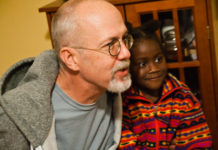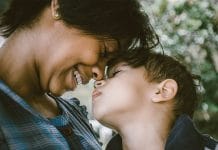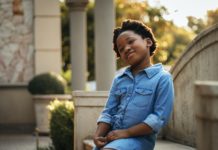In the beginning it was about wanting a baby. I desperately wanted a baby. Every single cell in my body was screaming to be pregnant. My late twenties and all of my thirties were dedicated to the goal of getting pregnant. I loved my husband and was sure that this pregnancy, and its inevitable outcome, a living child, would be the greatest fulfilled expression of love between us. I was a woman obsessed. In the beginning I acted selfishly and I behaved foolishly.
It took three people in a room to make it happen (me, my husband and our reproductive endocrinologist), but we did manage to get pregnant. I remember celebrating by going to lunch at a diner we had never been to. We slid into a red leather booth and called our own siblings with the good news. I was wearing a camel hair coat, a present my husband gave me as I was wheeled out of one of our IVF surgeries. It was a coat I had coveted because it reminded me of my own mother—warm, comforting and classy. I ordered a Greek salad dripping in feta cheese, panicking later when I read pregnant women aren’t supposed to eat non-pasteurized cheese. My child and I survived the cheese and for weeks I was ridiculously happy. I imagined that I must be glowing as I chewed my nausea-abating ginger candies, checked out What to Expect When You are Expecting from the library and made big plans for our finally promising future as somebody’s mommy and daddy.
When the doctor’s shoulders sank as he looked at the monitor is a moment that I will never, ever forget. “I’m sorry, there is no heartbeat.” Four pregnancies, four miscarriages and a bout of thyroid cancer later, it was clear that our Sisyphean attempt at procreation had to come to an end. We soon found ourselves sitting in the back row of a cold auditorium, depressed, dejected and broken. Scanning the audience of this adoption after infertility conference, I noticed that every single woman was quietly weeping. “Losers,” my husband said later, “A room full of losers.” That is what we were.
We listened as the panelists described the different ways to adopt. We opted for Foster-to-Adopt. We figured it was a win-win—local kids needed homes and we had one. It also wouldn’t cost anything, which was good since all of our money had been sunk into that fancy doctor’s office on Wilshire Boulevard. In hour twenty-eight of our thirty-hour foster-adoptive-parent training program, we were asked to do a role-playing exercise. I was given the role of the adoptive mother. Other people played the Department of Children and Family Services (DCFS) worker and the birth parents.
In the scenario, I am given a tiny baby by the DCFS social worker. I hold the baby, feed her and sing softly to her. I have a pretend visit with the birth mother. The birth mother leaves. Shortly after, the social worker comes back and tells me the baby is going to be returned to the birth mother. She quickly takes the baby out of my arms. Empty handed on a cold metal folding chair, I pretty much lost it. I knew then that I wasn’t strong enough to be a foster parent. In the beginning, when I thought about the birth parent, I had romanticized open adoption. The foster parenting social workers told us we should prepare to meet the birth parents at treatment centers, halfway houses and prisons. This part didn’t scare me as much as the giving the child back scenario. If I really did believe in the best thing for the child, I would be fully onboard and enthusiastic about the words family reunification. I wasn’t interested in what the birth parent needed; it was all about what I needed.
Domestic adoption seemed too competitive. I was sure that no birth mother would pick us—we were broke and we were broken. The thought of putting together a perky profile describing all of our great qualities seemed absurd. We weren’t great. I was of “advanced maternal age” and had battled cancer. The idea of an open domestic adoption, while nice in theory, seemed like something I was incapable of pursuing. I wanted that child to myself. I didn’t necessarily want to share.
My husband and I decided that we needed a sure thing–an adoption of orphans, not kids whose parents were having a tough time. Not wanting to root for someone else’s failure and not wanting to feel that drop to your knees anguish of losing a pregnancy, we moved on to international adoption. Our new adoption agency told us three country programs were open to couples that wished to adopt siblings, Ethiopia, Haiti and Russia. We knew that we wanted two children. We figured that our children would always have each other, they would always have someone who shared the same losses and they would have someone in the house that looked exactly like them. We chose Ethiopia because we knew there was a need. We assumed that adoptable children from Ethiopia would be orphans. Now things didn’t seem so greedy and selfish. I wanted desperately to be a mother, to raise a family with my husband, and children in Ethiopia had lost their parents, and they needed adoptive parents. We were in.
We settled in to wait for however long it took to bring us our happy ending. Reading our agency’s online forum, it became clear that hardly any of the Ethiopian children placed with adoptive parents had lost both of their birth parents. It turned out the orphan definition includes those children who have just one living birth parent. I remember my husband, Steven, said to me, “We need to call our agency and ask for kids who have lost both parents.” I told him, “This isn’t something you can request.”
Meazi and Melese’s Ethiopian father is a beautiful man. He is younger than I am, proud and has an excellent sense of humor. When the translator repeated his words that Meazi looks exactly like her late mother, a sound, dangerously close to a laugh, escaped my mouth. Looking at their father was like looking directly at Meazi. Their faces are so stunningly similar, their sparkly eyes practically identical. I can’t imagine a person who could have looked more like Meazi.
We sat with our social worker and our photo album in an empty room in rural Ethiopia, and it became instantly clear that despite what our adoption agency had us agree to, we wanted an open adoption with this man and with Meazi and Melese’s Ethiopian siblings. How could we not? Our open adoption means that we exchange pictures, videos, drawings and letters, and that we will visit when Melese is a little bit older. Although our agency agreed to make post-placement reports with photos available to their birth father, he would never have been able to travel to where they kept them. He didn’t have the bus fare, and he couldn’t take the time off from caring for his other four children. Without an open adoption, he never would have known how they were doing. We never would have known how he was doing.
Recently when relaying some news about this man to a wise friend she said, “Good news—sounds like your dealing with immediate family. Bad news—sounds like you’re dealing with immediate family.” Raising children with another family who live ten thousand miles away is complicated and challenging. Above all, we are trying to be as honest and open with our kids as we can. My daughter has lugged a heavy 8×10 framed picture of her Ethiopian family to school each fall. Last year in kindergarten the questions were simple, “How many cows did you have?” and “How many planes did you have to take to get to America?” This year, the questions from classmates are tougher, “Why are your brothers and sisters still there and you aren’t?”
At the end of the most recent video we received from Ethiopia, their father looks into the camera and says, “I hope your mother is nurturing you well and in a great way.” In the beginning, it was about me desperately wanting a baby. It was about wanting to raise a family with my husband. Now that I have the family I always wanted, I need to make sure that I am indeed, nurturing well and in a great way.
The other day, waiting in line to buy groceries, a stranger remarked, “You’ve got your hands full with those two!” Meazi looked at him and said, “You won’t believe this, but there are really six children in this family, talk about having your hands full!” She is right, in her family there are six children. There are also three living parents, on two different continents. Finding the very best way to help Meazi and Melese understand and come to grips with all of this is what occupies my thoughts. I don’t want to look back and realize that I acted selfishly and behaved foolishly.




































We recently opened our daughter’s Chinese adoption and we have also found it to be both amazing and really hard. I can’t imagine our daughter not knowing her Chinese parents and siblings. Meeting them and talking to them changed everything for us. I also feel like I know my daughter much better now because I can see so much of her family in her. International open adoption is not what we expected, but now I wouldn’t want it any other way.
Beautifully written, Julie. Our stories are very similar and I can’t tell you how much I appreciate your words.
Beautiful!!!!!
Beautiful, as always…
What a wonderful story of your struggles and triumps. Your parents should be so proud of you and those kids are very lucky to have you two to love and cherish.
Beautifully written and heart warming.
Thank you so much for your honesty. I can’t imagine the range of emotions you must have gone through. So glad you have such a happy ending!
[…] It was going to be super fun. Many of their friends were coming too, all of them kids who have been adopted from Ethiopia. We went to the show; Melese said that he had wished for more of a story, and Meazi, his sister, […]